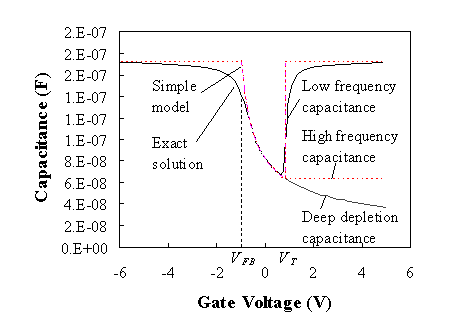mtwieg
Advanced Member level 6

I've been up on MOS capacitors and am having trouble figuring out the best way to implement high frequency bypass capacitors. It's a simple 5V 0.5um process without triple wells, so some implementations aren't available to me. My top priority is to get maximum capacitance density, but I'd also like to minimize ESR (so poly caps are not an option).
Initially I was planning on using accumulation PMOS with S+G+B tied to Vss and gates tied to Vdd. But someone pointed out that NMOS would have lower ESR due to lower channel resistance/higher electron mobility. But since I do not have any triple well, any NMOS would have to operate in inversion region, and from what I remember from school the high frequency capacitance in inversion is much lower than the depletion capacitance (I need to operate >100MHz). Does anyone know if BSIM models this high/low frequency capacitance difference?

But now that I look at it again, I'm wondering if that's only the case when you have no S/D diffusion areas, only a gate above bulk (who would actually use that?). But if I use an NMOS with S+G+B all tied to Vss, I've read in a couple places that you will see the "low frequency" capacitance even at high frequency. Is this true?
Also on the relative ESR of PMOS and NMOS caps, if the PMOS is in accumulation, doesn't that mean that the charge carriers in the bulk are majority electrons? So shouldn't they have high mobility, just like minority electrons in an inverted NMOS channel?
Initially I was planning on using accumulation PMOS with S+G+B tied to Vss and gates tied to Vdd. But someone pointed out that NMOS would have lower ESR due to lower channel resistance/higher electron mobility. But since I do not have any triple well, any NMOS would have to operate in inversion region, and from what I remember from school the high frequency capacitance in inversion is much lower than the depletion capacitance (I need to operate >100MHz). Does anyone know if BSIM models this high/low frequency capacitance difference?

But now that I look at it again, I'm wondering if that's only the case when you have no S/D diffusion areas, only a gate above bulk (who would actually use that?). But if I use an NMOS with S+G+B all tied to Vss, I've read in a couple places that you will see the "low frequency" capacitance even at high frequency. Is this true?
Also on the relative ESR of PMOS and NMOS caps, if the PMOS is in accumulation, doesn't that mean that the charge carriers in the bulk are majority electrons? So shouldn't they have high mobility, just like minority electrons in an inverted NMOS channel?

